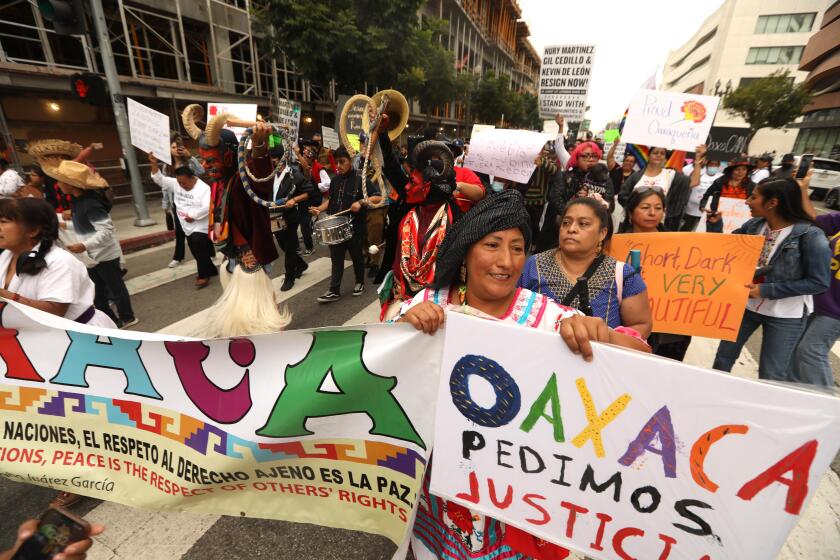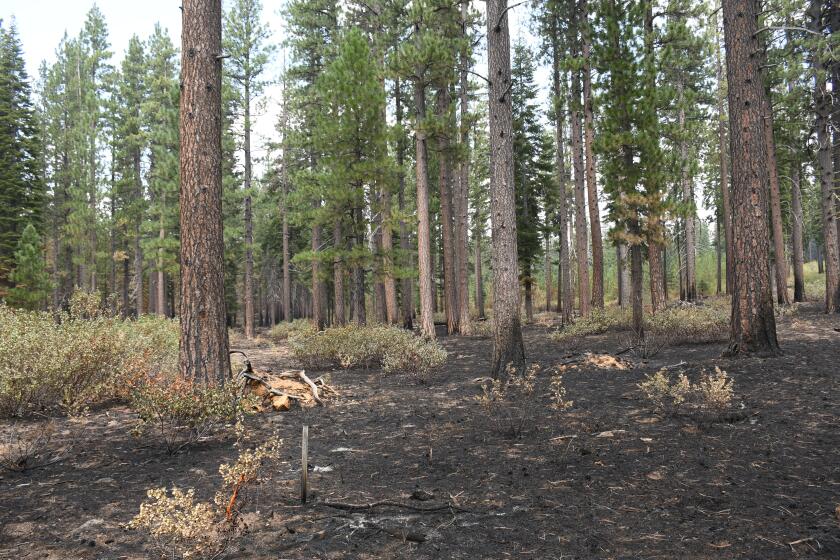Opinion: The deadly costs for Mexico’s Indigenous communities fighting climate change

- Share via
Mexico’s Indigenous communities are on the front lines of ecological preservation. Many still live on their ancestral lands and struggle against development projects that would destroy some of the world’s most precious ecosystems that they call home. Their resistance has taken the form of protests, blockades of major highways and the occupation of government buildings.
These communities are showing us how the fight against climate change begins at the local level. They also have valuable lessons to teach us about maintaining plants, fauna and species native to their lands. But Mexico has become the deadliest place in the world for environmental and land activists protecting Indigenous territories, according to the nonprofit Global Witness, which says 54 environmental and land defenders were killed in Mexico in 2021. We need to protect Indigenous people from increasingly violent threats, if we are to also protect our fragile environment.
As journalists, we have seen what communities are facing. We recently traveled to Paso de la Reina, a town where six Indigenous environmental activists have been killed over two years for defending their pristine Rio Verde River. The activists had protested against the construction of a hydroelectric dam and excessive sand and gravel mining on the riverbed, and set up a blockade on the road leading to their town and the Rio Verde.
The tendency to lump Indigenous communities under the broad umbrella of “Hispanic/Latino” erases the cultural richness of the many Indigenous groups and limits the language support they need.
This isolated Chatino and Mixtec Indigenous territory lies in the southern state of Oaxaca — a couple of hours drive from the beach resort of Puerto Escondido, popular with foreign tourists. Researchers told us they believe the activists were targeted for their environmental work. Prosecutors aren’t following up on the killings. And the Indigenous community has spoken to few reporters, providing no details about the killers, for they fear more reprisals.
Indigenous defenders are increasingly becoming the last line of defense for the environment in Mexico, playing an essential role in the monumental task of preserving the national biodiversity. Indigenous people comprise less than 5% of the world’s population, but take care of an estimated 80% of the earth’s biodiversity, according to the World Wildlife Fund. And Mexico is one of the seven most biodiverse countries on the North and South American continents, along with Brazil, Colombia, Peru, Ecuador, Venezuela and the United States.
Of these countries, Mexico possesses the largest percentage of land collectively owned by Indigenous and local communities.
A study by the Rights and Resources Initiative estimates that more than half of Mexico’s land is owned by Indigenous peoples and local communities. This is possible in large part because of Mexico’s specific so-called tierras ejidales and tierras comunales systems, both of which allow for collective property ownership in Mexico, often by Indigenous communities who exercise their political right to self-determination, guaranteed by the constitution.
But these progressive political reforms have not changed the aggression against Mexico’s Indigenous communities. Indigenous people, who represent more than 19% of the Mexican population, according to a government census — about 24 million people — have been under threat for centuries. First by Spanish colonial occupiers, then by the modern Mexican state, which massacred them repeatedly, forced intermixing and erased their culture.
This historic marginalization continues to hamper Indigenous people protecting ecosystems whose untapped natural resources are now sought after, to spur industrialization, economic growth and clean-energy production in the form of wind farms and hydroelectric dams.
Indigenous activists face threats from the Mexican federal and local governments, corporations and organized crime, the same entities that have made Mexico the world’s most dangerous country for journalists. Reporting on Mexican Indigenous defenders is rare in Mexico’s national press.
Western woodlands now vulnerable to megafires evolved to endure far more frequent and less catastrophic burns at the hands of local tribes.
On Indigenous communal land we recently visited in the isthmus of Tehuantepec, Oaxaca, the Mexican government wants to build an “Interoceanic Corridor,” a mega road, rail, pipeline and industrial project to rival the Panama Canal: linking the Atlantic and Pacific Oceans, with gigantic industrial complexes and refineries importing and exporting products along the way. U.S. authorities, such as U.S. ambassador to Mexico Ken Salazar, have also touted this project as a substitute for former President Trump’s infamous “wall” — an industrial, militarized frontier that will provide Central and South American migrants job opportunities, and also prevent them from crossing over into the United States by force.
This month the Mexican government announced it will begin receiving bids for this megaproject’s industrial parks from U.S., Mexican and multinational corporations. But a dozen different Indigenous communities live in the area encompassed by the Interoceanic Corridor, and many of them claim much of the disputed land as communal territory that belongs to them collectively.
It is unclear whether these Indigenous activists — sometimes carrying just machetes — can resist the Mexican Navy securing the Interoceanic megaproject since last October, backed by U.S. economic interests. Still, they are determined to defend their territories and ways of life — which are deeply intertwined.
Indigenous communities protecting precious natural resources deserve to be heard and incorporated in Mexican authorities’ political and economic decisions increasingly affecting their territories. Not only because they are the legal owners of their lands, but also because we might learn from their ways of life that have efficiently protected public goods like clean water, unpolluted air and biodiversity, sometimes for millennia. U.S. officials and companies pursuing development projects in Mexico should also respect and engage with Indigenous people.
Some communities have been successful in resisting environmental destruction and safeguarding their land. The Zapotec community of Magdalena Teitipac protested against the installation of a Canadian gold and silver mine in the Central Valleys of the state of Oaxaca, preserving precious underground aquifers in an increasingly arid Oaxaca. The Purhépecha community of Cherán, in the western state of Michoacán, banished criminal loggers from their forests after an uprising, and are now a self-determining community, reforesting their hills and deciding which economic interests can enter their territory.
If we fail to pay attention to and protect Indigenous voices, we all stand to suffer the consequences of our fading ecology.
Rafael E. Lozano is a journalist based in Oaxaca. Anjan Sundaram is the author of the memoir “Breakup: A Marriage in Wartime,” which will be published in April.
More to Read
A cure for the common opinion
Get thought-provoking perspectives with our weekly newsletter.
You may occasionally receive promotional content from the Los Angeles Times.












